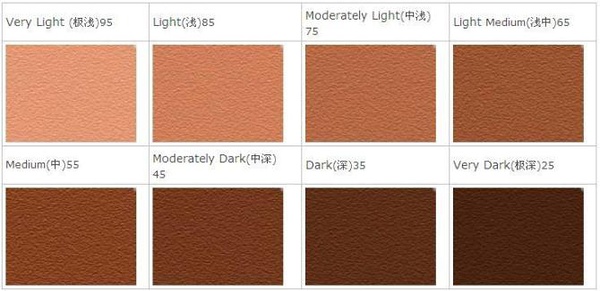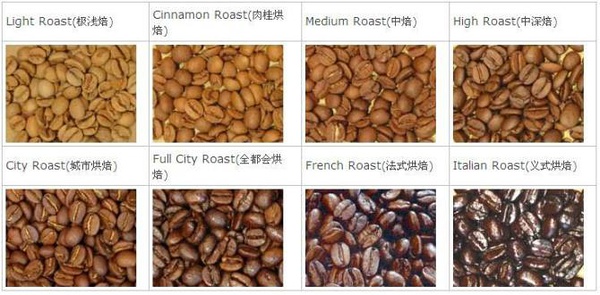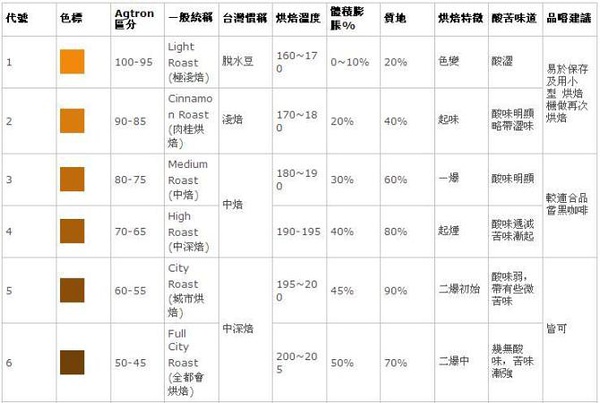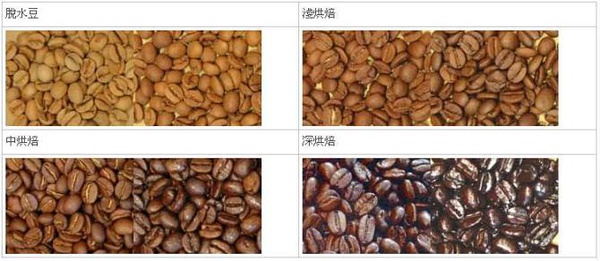Coffee roasting knowledge: coffee roasting degree resolution chart
American Coffee Association (SCAA) Roast Degree Standard This standard uses infrared caramelization tester technology (Agtron) to measure the color of coffee beans to determine the degree of roasting of coffee, and the color from light to dark into eight equal parts made of eight standard color blocks for the coffee industry as roasting identification.

The above colors are for reference only
This is also the earliest distinction of coffee roasting degree. Due to the different taste preferences of coffee roasting degree in various countries and regions, it is also known as roasting degree by country or region, such as Italian roasting, French roasting, etc. However, these different preferred baking degrees were integrated and arranged from light to dark to form a baking degree discrimination index, but because the standard was too general, different baking masters had different opinions on baking degrees.

The above colors are for reference only
Distinguishing the customary baking degree in Taiwan
In recent years, Taiwan has mostly locked in the explosion changes during baking to determine the degree of baking.


roasting degree Next bean time point
------------------------------------------------------------
Light (light) one burst dense
medium/city (medium/city) between primary and secondary explosions
Deep City (full city) Second explosion begins
Italian/French After Two Explosions

Coffee roasting
Through the burning of the fire, the aroma of coffee is released, and the character of each bean-sour, sweet and bitter-is fully expressed. From the tasteless raw beans to the endless fragrance in the cup-roasting is the most important stop in the long journey of each coffee bean to outline its character and nurture its aroma.
Whether in a professional roaster, on your own fire or in an oven, coffee beans must undergo multiple chemical changes during this 12-16 minute, 450 ° F (232 ° C) heated dialogue with the fire, emitting a second popcorn-like crisp sound and losing 15 - 25 percent of their weight in water.
The baking process, like popcorn full of flavor and pleasant bouncing sound. From raw beans, light, medium roast to deep roast, water release again and again, weight loss, volume slowly expand bulge, coffee beans color deepened, fragrant oil gradually released, texture also becomes crisp.
Green beans-Each coffee cherry contains two green beans, and the aroma is still deep inside, waiting to be discovered. Green beans contain large amounts of chloric acid, which gradually disappears during baking, releasing familiar and pleasant fruit acids such as acetic acid, citric acid, and malic acid found in wine. Baking just right will bring out these wonderful sourness in moderation, whereas baking too much will completely mask them.
Bake 5-7 minutes, beans begin to release water, light green to orange color, exudes creamy roasted vegetables unique aroma.
Light Roast-When the beans emit the first soft sound, the volume expands at the same time, and the color changes to a delicious cinnamon color, so it is also called cinnamon raost or half-city roast. Acidity dominates the flavor of light roasted beans, texture and taste are not fully developed, so generally used as canned coffee, can not satisfy the real coffee connoisseur.
Medium Roast-When roasted for 10-11 minutes, the coffee beans take on an elegant brown color. New Yorkers like to kick off the day with medium-roast coffee beans, rich milk and sugar at breakfast, hence the name breakfast roast or city roast. Medium roast can preserve the original flavor of coffee beans, but also can release moderate aroma, so Blue Mountain, Colombia, Brazil... For coffee, choose this method of roasting.
At 12-16 minutes, the oil begins to surface, the beans are burned by the fire pattern to a bright dark brown, called full-city roast, some people think, at this time coffee acid, sweet, bitter to achieve the most perfect balance point, coffee beans character is also clearly characterized.
Deep Roast-The darker the color of the coffee beans, the sweeter the flavor. When the oil has been caramelized, the bitterness returns to sweetness and the remaining flavor is endless. It is best for brewing strong Espresso coffee. Therefore, it is also called Italian Roast.
Moderate roasting gives life to coffee beans, turning them into sour, sweet, bitter and astringent when they are eaten. However, caffeine sensitive people, may wish to choose as far as possible deep-roasted beans, because in the roasting process, caffeine will slowly escape, so the more deep-roasted beans, the lower the caffeine content
● Note: The sourness and bitterness of the roast will still vary from coffee to coffee. Tasting suggestions are personal opinions, and the main drinking method varies from person to person.
Important Notice :
前街咖啡 FrontStreet Coffee has moved to new addredd:
FrontStreet Coffee Address: 315,Donghua East Road,GuangZhou
Tel:020 38364473
- Prev

Professional knowledge of coffee roasting (for enterprise training)
First, the mixing of coffee beans people need to combine coffee from different places for several different purposes. The ideal goal, of course, is to piece together a coffee that tastes better than any of them. But generally speaking, Arabica coffee from a single origin is enough to make coffee that tastes good for export; it has a delicate flavor, a soft taste and a sweet aftertaste. So you don't need it.
- Next

Coffee roasting terminology: caramelization tester (Agtron)
Coffee terminology: caramelization tester this is the baking degree index used in the United States. The baking degree ranges from the shallowest 100 to the deepest 25, which is expressed by the value that the baking degree is about Agtron 50. The determination is based on a special colorimeter called Agtron M-Basic. Baking degree digital range color group value very shallow baking 100-95 Tile#95 shallow baking 90-85 Tile#85
Related
- Beginners will see the "Coffee pull flower" guide!
- What is the difference between ice blog purified milk and ordinary milk coffee?
- Why is the Philippines the largest producer of crops in Liberia?
- For coffee extraction, should the fine powder be retained?
- How does extracted espresso fill pressed powder? How much strength does it take to press the powder?
- How to make jasmine cold extract coffee? Is the jasmine + latte good?
- Will this little toy really make the coffee taste better? How does Lily Drip affect coffee extraction?
- Will the action of slapping the filter cup also affect coffee extraction?
- What's the difference between powder-to-water ratio and powder-to-liquid ratio?
- What is the Ethiopian local species? What does it have to do with Heirloom native species?

